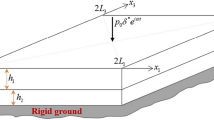Abstract
In this study, a three-layer axial symmetrical composite plate has simulated in numerical ANSYS and ABAQUS software. The structure has consisted of an elastic core (isotropic) and two piezoelectric layers (trans-trophic) that are symmetrical on both sides of an elastic layer. The elastic core is made of aluminum, and piezoelectric layers are in the form of piezoelectric materials (PZT5H). The polarization vector assumed on the Y-axis in simulation, and loading involves applying an electric charge (voltage) on the surface of the piezoelectric and imposing mechanical load (distributed load) on the upper plan level as well as the electromechanically load that is a combination. Boundary conditions include a hinged and fixed supports which are around the elastic layer. Analysis of the structure takes place in two static- and modal-state situations. Static analysis is conducted to determine the maximum deformation of the structure, and modal analysis is for calculating the natural frequencies and mode shapes of the plate in both short and open circuits. Finally, two software results are compared.










Similar content being viewed by others
References
Aldraihem OJ, Khdeir AA (2000) Smart beams with extension and thickness-shear piezoelectric actuators. Smart Mater Struct 9(1):1–9
American A, Standard N (1988) IEEE Standard on piezoelectricity: an American National Standard. ANSI/IEEE Std 176–1987:8–10
Babu J, Ramacahndran A, Philip J, Chandran CS (2016) Development of noise reduction panel using piezoelectric material. Proc Technol 25:1022–1029
Chen J, Qiu Q, Han Y, Lau D (2018) Piezoelectric materials for sustainable building structures: fundamentals and applications. Renew Sustain Energy Rev 101:14–25
Constantinou MC, Kalpakidis I, Filiatrault A, Lay RE (2011) LRFD-based analysis and design procedures for bridge bearings and seismic isolators. In: Mceer, vol MCEER-11-0, no. 65, pp 1–371
Crawley EF, De Luis J (1987) Use of piezoelectric actuators as elements of intelligent structures. AIAA J 25(10):1373–1385
Duan WH, Wang Q, Quek ST (2010) Applications of piezoelectric materials in structural health monitoring and repair: selected research examples. Materials (Basel) 3(12):5169–5194
Eringen AC, Maugin GA (1990) Electrodynamics of continua I. Springer, New York
Helwany S (2010) Applied soil mechanics with Abaqus applications. Wiley, New York
Khalili M, Biten AB, Vishwakarma G, Ahmed S, Papagiannakis AT (2019) Electro-mechanical characterization of a piezoelectric energy harvester. Appl Energy 253:113585
Lax M, Nelson DF (1971) Linear and nonlinear electrodynamics in elastic anisotropic dielectrics. Phys Rev B 4(10):3694–3731
Ledoux A, Nepf HM (2011) Theory of piezoelectric materials and their applications in civil engineering by OF TEC AR IES Chair, Departmental Committee r a Graduate Students, Massachusetts Institute of Technology
Li F, Li G (2015) Application of ANSYS APDL in the design of piezoelectric transducer. In: 5th Int Conf Adv Eng Mater Technol (AEMT 2015), pp 506–511
Popovici D, Constantinescu F, Maricaru M, Ioan Hantila F, Nitescu M, Gheorghe A (2008) Modeling and simulation of piezoelectric devices. IntechOpen, Rijeka
Pourianejad S, Movahedi B (2015) Solid-state synthesis of modified (Bi0.5Na0.5)TiO3 piezoelectric nanocrystalline ceramics and evaluating their properties. Mater Sci Semicond Process 29:337–344
Shen B, Yang X, Li Z (2006) A cement-based piezoelectric sensor for civil engineering structure. Mater Struct Constr 39(285):37–42
Yang J (2005) An introduction to the theory of piezoelectricity. Springer, New York
Yang JS, Batra RC (1995) Conservation laws in linear piezoelectricity. Eng Fract Mech 51(6):1041–1047
Author information
Authors and Affiliations
Corresponding author
Additional information
Publisher's Note
Springer Nature remains neutral with regard to jurisdictional claims in published maps and institutional affiliations.
Rights and permissions
About this article
Cite this article
Alimohammadi, H., Izadi Babokani, B. Finite element electrodynamics modeling of a layered piezoelectric composite shell with different materials by using numerical software. ISSS J Micro Smart Syst 9, 79–88 (2020). https://doi.org/10.1007/s41683-020-00052-3
Received:
Revised:
Accepted:
Published:
Issue Date:
DOI: https://doi.org/10.1007/s41683-020-00052-3



